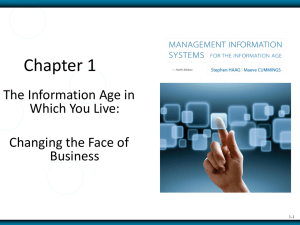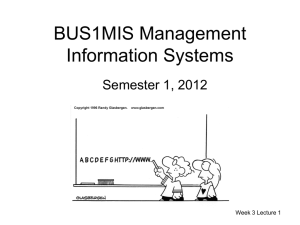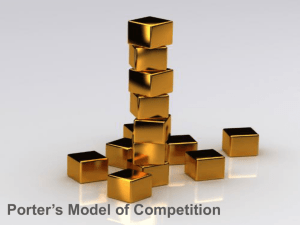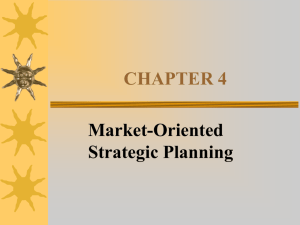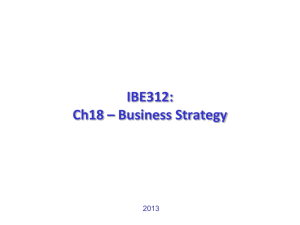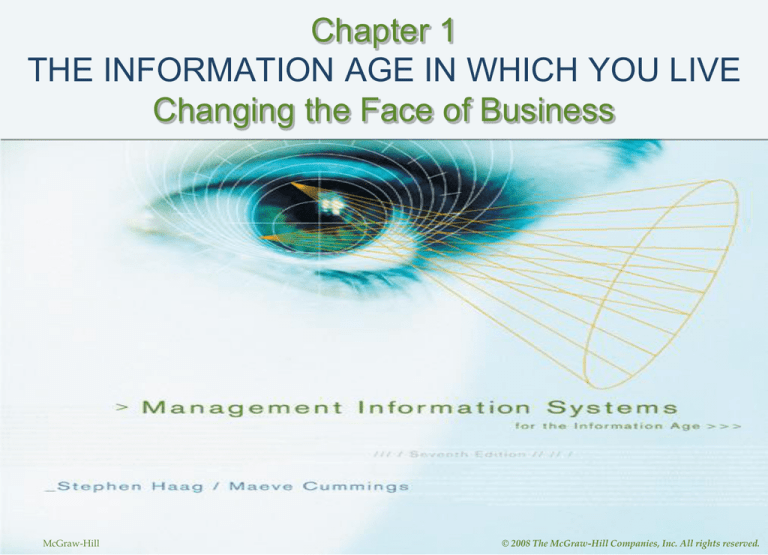
Chapter 1
THE INFORMATION AGE IN WHICH YOU LIVE
Changing the Face of Business
McGraw-Hill
© 2008 The McGraw-Hill Companies, Inc. All rights reserved.
STUDENT LEARNING
OUTCOMES
1.
2.
3.
4.
Describe MIS and the 3 important organizational
resources within it – people, information, and IT.
Describe how to use Porter’s Five Forces Model to
evaluate the relative attractiveness of an industry.
Compare and contrast Porter’s 3 generic
strategies, top line versus bottom line, and the rungrow-transform framework for developing business
strategy.
Describe the role of value-chain analysis for
identifying value-added and -reducing processes.
1-2
IS YOUR SOCIAL SECURITY
NUMBER WORTH $98?
Information technology has greatly accelerated
both the “good” and the “bad”
IT can be used to increase profit, reduce costs,
increase service quality, and benefit society
IT can also be used to steal your personal
information, commit fraudulent acts, etc
Many sites on the Web are – right now – selling
your personal information
1-3
What Your Personal Information Is
Worth?
$490 – credit card number and PIN
$147 – driver’s license number
$147 – birth certificate
$6 – PayPal logon and password
$78-$294 – billing data including account number,
address, birth date, etc
1-4
Questions
1.
2.
3.
Have you, a friend, or a family member been a
victim of identity theft? If so, tell the story to your
class.
How often do you buy your credit report? Did you
know you get one for free annually?
Is technology good or bad?
1-5
INTRODUCTION
You live in a digital age
Average American relies on more than 250
computers per day
According to Time magazine, 14% of cell phone
users stopped having sex to take a phone call
50 of the 2006 Fortune 500 companies were IT
companies
Dell Computer is one of them – it was started in
1984 and now has 65,000 employees worldwide
1-6
INTRODUCTION
This book is about the use of technology (called
management information systems or MIS) in
business
The modules (there are 13) teach you how to use
technology to increase your personal productivity
The chapters (there are 9) illustrate how
businesses use technology to…
Increase market share and profits
Eliminate time and location boundaries
Etc
1-7
Business Must Drive Technology
1-8
Business Must Drive Technology
1.
2.
3.
4.
Assess state of competition and industry
pressures affecting your organization
Determine business strategies to address
competitive and industry pressures
Identify business processes to support your
chosen business strategies
Align technology tools with those business
processes
NEVER DO THIS IN REVERSE!!
1-9
CHAPTER ORGANIZATION
Management Information Systems
1.
Learning Outcome #1
Porter’s Five Forces Model
2.
Learning Outcome #2
Porter’s Three Generic Strategies
3.
Learning Outcome #3
Value-Chain Analysis
4.
Learning Outcome #4
1-10
MANAGEMENT INFORMATION
SYSTEMS
MIS – planning for, development, management,
and use of IT tools to help people perform all tasks
related to information processing and
management
Three key resources in MIS
1.
2.
3.
Information
People
Information technology
1-11
Information Resource
Intellectual asset hierarchy – data, information,
business intelligence, knowledge
Data – raw facts that describe a particular
phenomenon such as the current temperature, the
price of movie rental, or your age
Information – data that have a particular meaning
within a specific context
1-12
Information Resource
Information is
often aggregated
data that has
meaning such as
average age,
youngest and
oldest customer,
and a histogram
of customer ages
Your age – a piece
of data
1-13
Information Resource
Business intelligence (BI) – collective
information about…
Customers
Competitors
Business partners
Competitive environment
BI is information on steroids
BI can help you make important, strategic
decisions
1-14
Information Resource
BI often combines multiple sets of information – customers, salespeople,
and purchases in this case.
1-15
Information Resource
Knowledge – broad term that can describe many
things…
1.
2.
3.
4.
Contextual explanation for business intelligence
Actions to take to affect business intelligence
Intellectual assets such as patents and trademarks
Organizational know-how for things such as best
practices
1-16
Information Resource – Quality
Attributes
Timeliness
When you need it
Describing the right time period
Location (no matter where you are)
Form (audio, text, animation, etc)
Validity (credibility)
Lack of any of the above can create GIGO
(garbage-in, garbage-out) in a decision-making
process
1-17
Information Resource –
Organizational Perspective
1-18
Information Resource – Flows of
Information
Upward – describes state of the organization
based on transactions
Downward – strategies, goals, and directives that
originate at a higher level and are passed to lower
levels
Horizontal – between functional business units
and work teams
Outward/inward – from and to customers,
suppliers, distributors, and other partners
1-19
Information Resource – What It
Describes
Internal information – specific operational
aspects of the organization
External information – environment surrounding
the organization
Objective information – quantifiably describes
something that is known
Subjective information – attempts to describe
something that is unknown
1-20
People Resource
People are the most important resource in any
organization, with a focus on
Technology literacy
Information literacy
Ethical responsibilities
1-21
People Resource
Technology-literate knowledge worker – knows
how and when to apply technology
Information-literate knowledge worker
Can define information needs
Knows how and where to obtain information
Understands information
Acts appropriately based on information
Ethics – principles and standards that guide our
behavior toward other people
1-22
People Resource - Ethics
You always want
your actions to fall in
Quadrant I – both
ethical and legal.
1-23
Information Technology Resource
Information technology (IT) – computer-based
tools that people use to work with information
Hardware – physical devices that make up a
computer
Software – set of instructions that your hardware
executes to carry out a specific task for you
1-24
Information Technology –
Hardware
1-25
Information Technology –
Hardware
1.
2.
3.
4.
5.
6.
Input device – tool for entering information and
commands
Output device – tool for see or hearing results
Storage device – tool for storing information
CPU – hardware that interprets and executes
instructions (RAM temporarily stores information
and software for the CPU)
Telecommunications device – for sending info
Connecting devices – like cables, ports, etc.
1-26
Information Technology –
Software
Two types of software
Application software – enables you to solve
specific problems and perform specific tasks
(Word, payroll, inventory management, etc)
System software – handles tasks specific to
technology management (operating system, antivirus, etc)
See Extended Learning Module A for a review of IT
hardware and software
1-27
PORTER’S FIVE FORCES
MODEL
The Five Forces Model helps business people
understand the relative attractiveness of an
industry and the industry’s competitive pressures
in terms of
1.
2.
3.
4.
5.
Buyer power
Supplier power
Threat of substitute products or services
Threat of new entrants
Rivalry among existing competitors
1-28
PORTER’S FIVE FORCES
MODEL
1-29
Buyer Power
Buyer power – high when buyers have many
choices and low when their choices are few
Competitive advantages are created to get buyers
to stay with a given company
NetFlix – set up and maintain your movie list
United Airlines – frequent flyer program
Apple iTunes – buy/manage your music
Dell – customize a computer purchase
1-30
Buyer Power
Competitive advantage – providing a product or
service in a way that customers value more than
what the competition is able to do
First-mover advantage – significant impact on
gaining market share by being the first to market
with a competitive advantage
All competitive advantages are fleeting
E.G., all airlines now have frequent flyer programs
1-31
Supplier Power
Supplier power – high when buyers have few
choices and low when choices are many
The opposite of buyer power
1-32
Threat of Substitute Products and
Services
Threat of substitute products and services –
high when there are many alternatives for buyers
and low when there are few alternatives
Switching costs can reduce this threat
Switching cost – a cost that makes buyers
reluctant to switch to another product/service
Long-term contract with financial penalty
Great service
Personalized products based on purchase history
1-33
Threat of New Entrants
Threat of new entrants – high when it is easy for
competitors to enter the market and low when
entry barriers are significant
Entry barrier – product or service feature that
customers have come to expect and that must be
offered by an entering organization
Banking – ATMs, online bill pay, etc
1-34
Rivalry Among Existing
Competitors
Rivalry among existing competitors – high
when competition is fierce and low when
competition is more complacent
General trend is toward more competition in
almost all industries
IT has certainly intensified competition in all
sectors of business
1-35
PORTER’S THREE GENERIC
STRATEGIES
Porter identified
3 generic
business
strategies for
beating the
competition
1.
2.
3.
Overall cost
leadership
Differentiation
Focus
1-36
Overall Cost Leadership
Overall cost leadership – offering the same or
better quality product or service at a price that is
less than what any of the competition is able to do
Wal-Mart (Always Low Prices, Every Day Low
Prices)
Dell – a computer the way you want it at an
affordable price
Hyundai and Kia – reliable low-cost cars
Grocery stores – high-volume, low-margin
1-37
Differentiation
Differentiation – offering a product or service that
is perceived as being “unique” in the marketplace
Hummer – Like Nothing Else
Audi and Michelin – safety
Lund’s & Byerly’s – high-end grocery store
1-38
Focus
Focus – focusing on offering products or services
To a particular segment or buyer group
Within a segment of a product line
To a specific geographic market
Examples
Restaurants
Physician offices
Legal offices
1-39
Alternative Business Strategy
Frameworks
Top line versus bottom line – should your strategy
focus on reducing costs (bottom line) or increasing
revenues (top line)
Run-grow-transform (RGT) framework – the
allocation in terms of percentages of IT dollars on
various types of business strategies
1-40
Top Line Versus Bottom Line
1-41
Top Line Versus Bottom Line
Top Line (increase revenue)
Reach new customers
Offer new products
Cross-selling
Offering complimentary products
Bottom line (minimize expenses)
Optimizing manufacturing processes
Decreasing transportation costs
Minimizing errors in a process
1-42
RGT Framework
How will you allocate IT dollars to
Run – optimizing execution of existing processes
Grow – increasing market share, products, and
service offerings
Transform – innovating business processes,
products, and/or services
1-43
Porter, Top Line/Bottom Line, RGT
Run = overall cost leadership = bottom line
Grow = focus and differentiation = top line
Transform = (new) differentiation = top line (when
the focus is innovation)
1-44
VALUE-CHAIN ANALYSIS
Value-chain analysis – systematic approach to
assessing and improving the value of business
processes
Value chain – chain or series of business
processes, each of which adds value to your
organization’s products or services
Business process – standardized set of activities
that accomplishes a specific task
Two types of processes: Primary and Support
1-45
VALUE-CHAIN ANALYSIS
1-46
VALUE-CHAIN ANALYSIS
Primary value process – takes in raw materials
and makes, delivers, markets and sells, and
services your products and services
Support value process – supports the primary
value processes
Ask customers which processes add value and
which processes reduce value
Focus IT appropriately
1-47
VALUE-CHAIN ANALYSIS
VALUE-ADDED PROCESSES
1-48
VALUE-CHAIN ANALYSIS
VALUE-REDUCING PROCESSES
1-49

